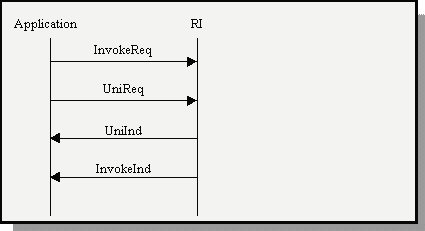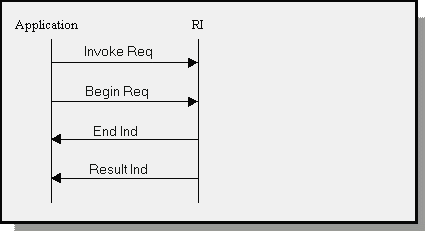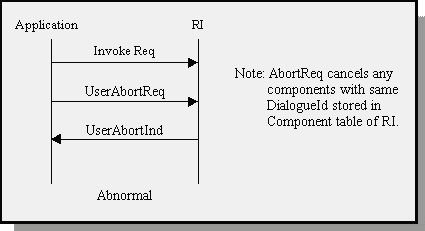

JAIN TCAP Reference Implementation (RI) Specification
Version 1.1
Copyrights
Copyright - 1999 Sun Microsystems, Inc. All
rights reserved.
901 San Antonio Road, Palo Alto, California
94043, U.S.A.
This product and related documentation are
protected by copyright and distributed under
licenses restricting its use, copying, distribution,
and decompilation. No
part of this product or related documentation
may be reproduced in any form by any means
without prior written authorization of Sun
and its licensors, if any.
RESTRICTED RIGHTS LEGEND: Use, duplication, or disclosure by the United States Government is subject to the restrictions set forth in DFARS 252.227-7013 (c)(1)(ii) and FAR 52.227-19.
The product described in this manual may be protected by one or more U.S. patents, foreign patents, or pending applications.
TRADEMARKS
Sun, the Sun logo, Sun Microsystems, Java, Java Compatible, JavaBeans, Solaris,Write Once, Run Anywhere, JDK, Java Development Kit, and JavaStation are trademarks or registered trademarks of Sun Microsystems, Inc. in the U.S. and certain other countries. UNIX is a registered trademark in the United States and other countries, exclusively licensed through X/Open Company, Ltd. All other product names mentioned herein are the trademarks of their respective owners.
THIS PUBLICATION IS PROVIDED AS IS WITHOUT WARRANTY OF ANY KIND, EITHER EXPRESS OR IMPLIED, INCLUDING, BUT NOT LIMITED TO, THE IMPLIED WARRANTIES OF MERCHANTABILITY, FITNESS FOR A PARTICULAR PURPOSE, OR NON-INFRINGEMENT.
THIS PUBLICATION COULD INCLUDE TECHNICAL INACCURACIES OR TYPOGRAPHICAL ERRORS. CHANGES ARE PERIODICALLY ADDED TO THE INFORMATION HEREIN; THESE CHANGES WILL BE INCORPORATED IN NEW EDITIONS OF THE PUBLICATION. SUN MICROSYSTEMS, INC. MAY MAKE IMPROVEMENTS AND/OR CHANGES IN THE PRODUCT(S) AND/OR THE PROGRAM(S) DESCRIBED IN THIS PUBLICATION AT ANY TIME.
Java APIs for the Integrated Network (JAIN) Framework brings Service Portability and Network Convergence into the Telephony Network. JAIN encompasses a standard set of interfaces for service creation and a number of standard interfaces for service execution.
The purpose of this document is to2.1 Support SoftwareThe JAIN TCAP RI will emulate the functions of an SS7 stack (but will not be an SS7 stack) in order to verify the requirements within this specification. The intention of the JAIN TCAP RI is not to implement an SS7 stack or to replace vendor SS7 stacks. The purpose of the JAIN TCAP RI is to provide a means to verify that JAIN TCAP applications are compatible with the JAIN TCAP specification. The RI can be used in order to help develop a JAIN TCAP application. The JAIN TCAP RI handles 'normal' TCAP message sequencing see Figure 5.1, however, it also allows for some abnormal conditions, see Figure 5.3.
- Outline the requirements and procedure for setting up the Reference Implementation (RI) which JAIN TCAP applications can run against.
- Outline the procedure for sending messages to the JAIN TCAP RI.
- List the scope and limitations of the JAIN TCAP RI.
Several classes developed with JDK1.3 and the JAIN TCAP API specification will be used while running the RI.
1. The Reference Implementation is utilized by implementing a JAIN TCAP API specification.
2. Java Virtual Machine.
3. An implementation of the JAIN TCAP Listener.
3.0 Initial set up for RI
The setup for the RI is initialized by a
JAIN TCAP Application. A diagram to illustrate
the procedures involved on setting up the
RI is shown in Figure 3.1.
After the initial setup, the JAIN TCAP Application should be capable of sending Request Events to the RI, and receiving Indication Events with corresponding parameters set from the RI.
Messages are sent from an Application through the RI, to the addressed Destination node. Any messages sent from the Application will be expected to be routed through the RI to the Destination node. The destination node may be the same Application or another Application with the same Signaling Point Code but different Sub System Number (SSN). The RI can handle a multiple listener to provider relationship see Figure 4.1.Figure 4.1 - JAIN TCAP RI Initial Set Up
In order to send events the Application running against the RI will construct Request Events i.e. Dialogues and some (if any) associated Components.
These Events are passed to the RI's Provider (here after referred to as RI_Provider) by invoking :
sendComponentReqEvent(componentRequest)The events are passed as parameter arguments within the method calls.
sendDialogueReqEvent(dialogueRequest).
- The RI_Provider accepts these events. If a component is received it will be added to the ComponentRequest Table. It is stored relative to that component's DialogueId. If other components with the same DialogueId have previously been received it is stored referenced by this index, otherwise it is added as a new entry in the table. A received Dialogue triggers the sending of associated components (i.e. those with the same Dialogue ID as the received Dialogue) see Figure 4.2.
Figure 4.2 - The Component Request Table.
Any associated Components are passed to the Convertor. This converts the Requests to Indication events. The Component Indications are passed to the Component Indication table and stored in a similar fashion to the Component Request table.
The Dialogue is converted to a Dialogue Indication event and passed to the Application by invoking the Application's processDialogueIndEvent(dialogueInd).
The associated components are then passed to the Application by invoking the Application's processDialogueIndEvent(componentInd).

Figure 4.3 - JAIN TCAP API RI Message routing.
The RI does not exhibit all the functionality of a TCAP stack. It handles normal TCAP message sequencing and some abnormal conditions.It can handle the following Request primitives :
It will return the appropriate Indication type with corresponding parameters set.
- UniDirectional Request Event
- Begin Request Event
- Continue Request Event
- End Request Event
- UserAbort Request Event
- Invoke Request Event
- Result Request Event
- Error Request Event
- Reject Request Event
- User Cancel Request Event
Example message sequences

Figure 5.1 - Message exchange for an unstructured Dialogue.

Figure 5.2 - Message exchange for a structured Dialogue.

Figure 5.3 - Message exchange for example Abnormal Dialogue.
- This release of the RI does not have the functionality to handle multiple providers.
- This release of the RI will return all Mandatory and any Optional parameters for the protocol variant it is running on, e.g. ITU, ANSI.
| ANSI | American National Standards Institute |
| API | Application Programming Interface |
| TCK | Technology Compatibility Kit |
| ITU | International Telecommunications Union |
| JAIN | Java APIs for Integrated Network |
| JDK | Java Development tool Kit |
| TCAP | Transaction Capabilities Application Part |
| RI | Reference Implementation |
Document ID: RI-JAINTCAP-001 Version: 1.0 Location: $JAIN_HOME/devilerables/documents/tcap/v1_0/ri/Tcap_RI_Specv1_0.html Originator Aidan McGowan Approval Date: 20th August 1999 Status: Approved
Document ID: RI-JAINTCAP-001-d Version: 1.0d Location: $JAIN_HOME/devilerables/documents/tcap/v1_0d/ri/Tcap_RI_Specv1_0d.html Modified Aidan McGowan and Phelim O'Doherty Approval Date: 17th June 2000 Status: Approved
Document ID: RI-JAINTCAP-001 Version: 1.1 Location: $JAIN_HOME/devilerables/documents/requirements/tcap/v1.1/ri/Tcap_RI_Specv1_1.html Modified Eugene Bell and Phelim O'Doherty Approval Date: 05th Sept 2001 Status: Approved